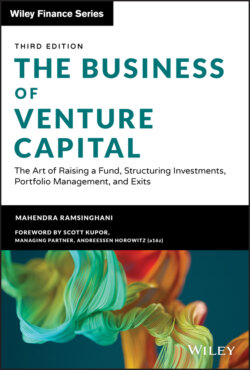Читать книгу The Business of Venture Capital - Mahendra Ramsinghani - Страница 20
ROLES, RESPONSIBILITIES, AND COMPENSATION
ОглавлениеIn any venture firm, the cast of characters includes the GPs (also known as managing directors or managing GPs), vice presidents, principals, associates, and analysts (Exhibit 1.3). These primary investment professionals are responsible for generating returns. Newer titles have evolved as fund operations have become more focused. For example, in larger funds, roles such as director of business development or the head of deal sourcing have emerged. The administrative team, also referred to as the back office, is responsible for the day-to-day operational aspects. This team includes chief operating officer, chief financial officer, general counsel administrative, and human resources.
Exhibit 1.3 Fund organization chart.
The primary responsibilities of the investment team differ along the lines of seniority. On any typical day, the GPs would juggle a number of activities: negotiating terms for investment opportunities, participating in boards of current portfolio companies, responding to any LP/investor requests, and putting out a few fires along the way. On a rare day, exit negotiations may occur. An entry-level analyst is expected to source investment opportunities and conduct the first screening of due diligence. At the other end of the spectrum, the partners keep a close watch on portfolio construction, governance, exits, and strategy and timing of the next fund. The typical compensation package includes a salary, annual performance bonus, and a share of the profits called carry, which stands for carried interest.
As they say, any fool can write a check, but it takes some skill (and luck) to generate financial returns. To select and win the right investment opportunity in a highly competitive environment calls for a blend of analytical rigor and speed, with a strong brand and network of relationships. Yet despite all the front-end challenges, almost 80 percent of all investments fail. Unproven technologies, shifting market dynamics, management team challenges, competition, and regulation can kill a company. Any venture fund's portfolio will eventually end up with a mix of successes, some average outcomes, and flameouts. A typical rule of thumb is that one-third of the portfolio companies return 5X to 10X multiple of invested capital; one-third will generate lower outcomes — say 1X to 2X of invested capital, and the final one-third of the portfolio will fail — be the scars on the back, relegated to the “experience” bucket as total losses.
Returns are measured by MOIC and IRR. While the multiple of invested capital is often touted as a metric of success, it is equally important to demonstrate speed. The IRR is a function of time. Its underlying notion of time-value of money implies that a dollar today is more valuable than a dollar tomorrow. Put a different way, time is your enemy. The faster you can sell, or exit, a portfolio company, for as high an amount, the higher the IRR. As seen in Exhibit 1.4, the holding period of an investment can have a significant impact on IRR, while the multiple on invested capital remains the same.
A fund's portfolio companies are reduced to a single line statistic — measured primarily by multiple of invested capital and gross IRR. See Exhibit 1.5.
On the surface, the business looks like a fascinating game, where you can write large checks, dole out advise to founders, and write blog posts in media touting your investment thesis. Beneath the surface, there is a fair amount of uncertainty, stress, competition, and turmoil. As Sir Michael Moritz of Sequoia Capital once said, “It is a business of a thousand soap operas.”
Exhibit 1.4 The Advantages of Shorter Holding Periods.
| Company | Capital Invested ($m) | Realized Value ($m) | Holding Period (years) | Multiple on Invested Capital (MOIC) | Gross IRR (%) |
|---|---|---|---|---|---|
| Company 1 | $1.0m | $5.0m | 2 | 5X | 123.6 % |
| Company 2 | $1.0m | $5.0m | 6 | 5X | 37.9 % |
Exhibit 1.5 Fund Portfolio Returns.
| Portfolio Company | Capital Invested ($m) | Current Value ($m) | Multiple on Invested Capital (MOIC) | Gross IRR |
|---|---|---|---|---|
| Company A | $6.50 | $39.20 | 6.08X | 60.60 % |
| Company B | $2.10 | $2.10 | 1X | 0.00 % |
| Company C | $9.60 | $33.10 | 3.8X | 46.20 % |
| Company D | $6.80 | $0.60 | 0.09X | –53.00 % |
| Fund | $25.00 | $75.00 | 3.00X | 51.2 % |
